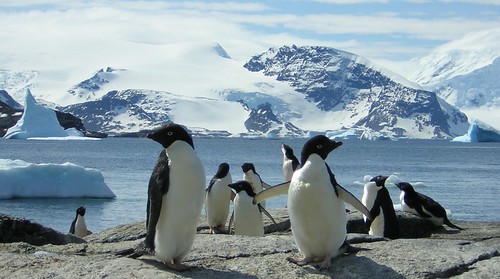Noah's adventures are rather different from Jim and Ann's in several key respects. Geographically, he begins from New Zealand, flying to McMurdo Station and then on to a tiny research station. Economically, he is not a tourist paying many thousands of dollars for the experience but rather the prototypical "starving student" who lucks into a research assistant position at the ends of the earth. And ornithologically, he is not on the frozen continent to build a life list but rather to research that most unique of avifauna - the penguin.
 |
| Adelie Penguins (image by jWOUW! from Flickr under Creative Commons license) |
When the book is focused on the Antarctic environment it paints a vivid picture of the life of a wildlife biologist in an extreme environment. Some detail is provided about the purpose, methods, and results of the research being conducted and, while the scientist in me craved a little more detail, the depth of this material is probably appropriate for the scope of the book. Noah's obvious passion for his subject shines through the text and I was quickly drawn into the experience of Antarctic life. More disappointing were the sections on Noah's personal history. There is no doubting his passion or aptitude (he was the ABA Young Birder of the Year in 2004) but some of his comments about the merits of his peripatetic lifestyle rubbed me the wrong way. It's not that I don't respect his choice - and a part of me is more than a little jealous - but in my opinion his message would be clearer if presented with a little more humility and maturity.
Overall I enjoyed reading about Noah's adventures and give this book a qualified recommendation: it is an essential read for anyone with an interest in Antarctic travel and wildlife and may be of interest to those readers looking to immerse themselves in an enthusiastic young birder's adventures in field research.

.jpg)
No comments:
Post a Comment